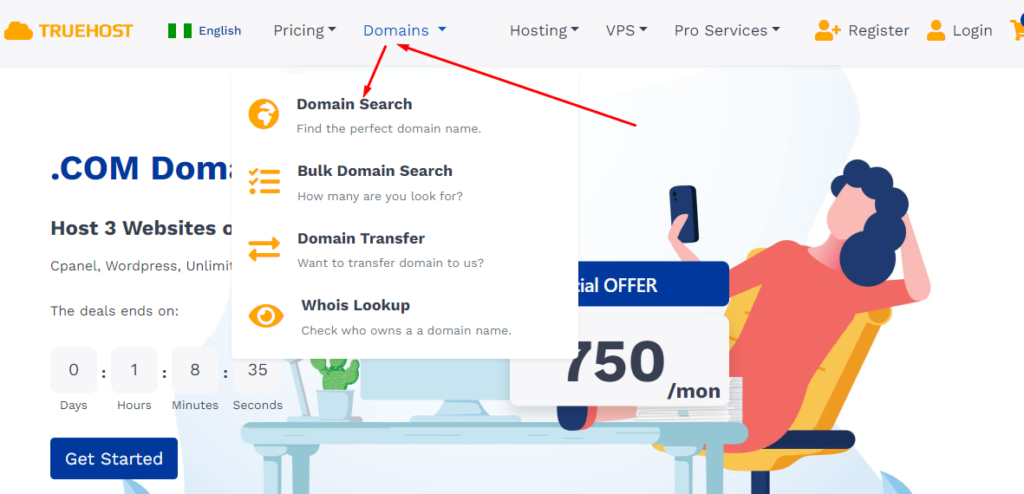Are you ready to unlock the power of e-commerce in Nigeria?
Discover the secrets of building a successful online store with WordPress.
In a world where digital transactions are booming, creating an online store has become an essential step for businesses aiming to thrive in the Nigerian market.
With WordPress as your platform of choice, you have the tools and flexibility to bring your entrepreneurial dreams to life.
From choosing a domain name that resonates with your brand to customizing your store’s appearance with captivating themes, this guide will walk you through each step of the process.
Get ready to captivate your customers, boost sales, and establish a formidable online presence.
Don’t miss out on this opportunity – let’s dive into the exciting world of e-commerce with WordPress.
What is WordPress and Why Use It?
WordPress is a powerful and versatile content management system (CMS) that allows users to create and manage websites with ease.
Originally designed for blogging, it has evolved into a comprehensive platform used by millions worldwide for various types of websites, including online stores.
According to BuiltWith.com, there are over 50K websites using WordPress in Nigeria.
This begs, why?
What sets WordPress apart is its user-friendly interface, extensive customization options, and a vast library of themes and plugins.
It empowers individuals and businesses to establish a professional online presence without the need for extensive coding knowledge or technical expertise.
WordPress offers a plethora of benefits for creating an online store in Nigeria.
First, it’s cost-effective, as the software itself is free and open-source.
It provides a robust foundation for e-commerce functionality through plugins like WooCommerce, making it an ideal choice for entrepreneurs seeking to establish their digital storefronts.
Moreover, WordPress is highly scalable, allowing your online store to grow along with your business.
So, whether you are a small business owner, an aspiring entrepreneur, or an established enterprise, harnessing the power of WordPress can pave the way for success in the dynamic world of online commerce.
Setting Up Your WordPress Website in Nigeria
1. Choosing a domain name for your online store
Selecting a domain name that aligns with your brand and is memorable to customers is crucial.
Consider incorporating relevant keywords and keeping it concise and easy to spell.
Utilize domain name registrars that cater to the Nigerian market.
And one of the best domain name registrars in Nigeria is Truehost.com.ng.
You can get a domain for as low as NGN.1200.
To register a domain, go to https://truehost.com.ng/

And domains then Domain search.
From here, search for your best domain and add it to cart.
2. Selecting a reliable web hosting provider in Nigeria
To ensure optimal performance and accessibility, choose a reputable web hosting provider that offers servers in Nigeria.
Consider factors such as uptime, customer support, and scalability to meet the demands of your growing online store.
Lucky for you, Truehost offers one of most reliable web hosting services in Nigeria.
We have a team of experts on stand by 24/7 ready to help you anytime you have an issue.
Our hosting packages start from NGN600 per month.

And you have other options with even better features!
3. Installing WordPress on your hosting account
Most hosting providers offer a one-click WordPress installation process.
When you buy hosting from us, you get access to a cPanel.
This is a simple control panel you can using to manage your hosting account.
And that includes installing WordPress in Nigeria!
Here are the steps on how to install WordPress using cPanel:
- Log in to your cPanel account.
- Click on the Software tab.
- In the Site Software section, click on the WordPress icon.
- On the WordPress Install page, enter the following information:
- Installation URL: This is the address of your website where WordPress will be installed. For example, if your domain name is example.com, your installation URL would be https://example.com.
- Admin Username: This is the username for the WordPress administrator account.
- Admin Password: This is the password for the WordPress administrator account.
- Click on the Install button.
WordPress will be installed on your hosting account.
Once the installation is complete, you will be redirected to the WordPress login page.
Here are some additional tips for installing WordPress using cPanel in Nigeria:
- Make sure that your domain name is pointed to your web hosting account.
- Make sure that your web hosting account has enough space to store WordPress files.
- If you are having trouble installing WordPress, you can contact us for help.
4. Customizing the appearance of your online store with a suitable theme
Choose a visually appealing and responsive theme that suits your brand image and showcases your products effectively.
Here are the steps on how to check and install a WordPress theme to an online store:
- Log in to your WordPress dashboard.
- Go to Appearance > Themes.
- On the Themes page, you will see a list of all the themes that are installed on your website.
- To check if a theme is compatible with WooCommerce, look for the WooCommerce Compatible label.
- If the theme is compatible with WooCommerce, you can install it by clicking the Install button.
- Once the theme is installed, you can activate it by clicking the Activate button.
Here are some additional tips for checking and installing WordPress themes to an online store:
- Make sure that the theme is designed for the version of WordPress that you are using.
- Read the theme’s documentation carefully to make sure that it is compatible with all of the features that you want to use.
- If you are having trouble installing or activating a theme, you can contact the theme’s developer for help.
Here are some of the best WordPress themes for online stores in Nigeria:
- Astra: Astra is a popular and versatile theme that is perfect for online stores of all sizes. It is easy to customize and comes with a wide range of features, including WooCommerce support.
- OceanWP: OceanWP is another popular and versatile theme that is perfect for online stores. It is also easy to customize and comes with a wide range of features, including WooCommerce support.
- GeneratePress: GeneratePress is a lightweight and fast theme that is perfect for online stores that need to load quickly. It is also easy to customize and comes with a wide range of features, including WooCommerce support.
Once you have installed a theme, you can start customizing it to match your brand and style.
You can change the colors, fonts, and layout of the theme to create a unique look for your online store. You can also add your own content, such as products, pages, and blog posts.
Customize the theme to align with your desired aesthetics and incorporate branding elements.
5. Essential plugins to enhance your store’s functionality
There are many great plugins available for WordPress, but some of the most essential plugins for an online store include:
- WooCommerce: WooCommerce is the most popular eCommerce plugin for WordPress. It allows you to create a fully-functional online store with a wide range of features, including product management, shipping, payments, and more.
- Wordfence: Wordfence is a security plugin that helps to protect your WordPress website from hackers and other online threats. It includes a variety of features, such as firewall protection, malware scanning, and intrusion detection.
- Yoast SEO: Yoast SEO is a plugin that helps to improve your WordPress website’s search engine ranking. It includes a variety of features, such as keyword research, title optimization, and meta description optimization.
- OptinMonster: OptinMonster is a lead generation plugin that helps you to capture email addresses from your website visitors. It includes a variety of optin forms, such as lightboxes, floating bars, and sidebar forms.
- Mailchimp: Mailchimp is an email marketing service that helps you to send email newsletters to your customers. It includes a variety of features, such as email list management, email automation, and email analytics.
These are just a few of the many great plugins available for WordPress.
With the right plugins, you can make your online store more secure, more visible, and more effective.
While choosing plugins for your online store in Nigeria, consider the following:
- Read reviews before you install any plugin. This will help you to make sure that the plugin is reliable and compatible with your WordPress website.
- Only install plugins that you need. Too many plugins can slow down your website.
- Keep your plugins up to date. This will help to protect your website from security vulnerabilities.
Once you have them, install and activate essential plugins to extend the functionality of your online store.
For a quick process, consider plugins for search engine optimization (SEO), security, analytics, and social media integration.
And don’t forget to customize the settings of each plugin as per your requirements.
Configuring WooCommerce Plugin
1. Introduction to WooCommerce as the leading e-commerce plugin for WordPress
WooCommerce is a powerful and widely used e-commerce plugin that seamlessly integrates with WordPress.
It offers robust features, including product management, secure payment gateways, shipping options, and order management.
2. Installing and activating the WooCommerce plugin
Here are the steps on how to install and activate WooCommerce in Nigeria:
- Log in to your WordPress dashboard.
- Go to Plugins > Add New.
- In the search bar, type WooCommerce and press Enter.
- Click Install Now next to WooCommerce.
- Once WooCommerce is installed, click Activate.
- WooCommerce will now be activated on your WordPress site. You will be redirected to the WooCommerce setup wizard.
- Follow the instructions in the WooCommerce setup wizard to configure your store.
Once you have completed the WooCommerce setup wizard, you will be able to start adding products to your store and accepting payments from customers.
3. Configuring general settings for your online store
Configure general settings such as currency, shipping locations, tax settings, and product display options.
Tailor these settings to comply with Nigerian regulations and cater to your target audience.
4. Setting up payment gateways to facilitate online transactions
Integrate popular payment gateways that are widely used in Nigeria, such as Paystack, Flutterwave, or Interswitch.
To cater to local customers, integrate Nigerian payment gateways that offer local payment methods, including bank transfers, mobile money, and USSD codes.
Provide clear instructions on how customers can make payments using these methods.
For example, here are the steps on how to connect Paystack with Woocommerce in Nigeria:
- Install the Paystack WooCommerce plugin. You can do this by going to WooCommerce > Plugins > Add New. In the search bar, type Paystack WooCommerce and press Enter. Click Install Now next to Paystack WooCommerce. Once WooCommerce is installed, click Activate.
- Go to WooCommerce > Settings > Payments. You’ll see Paystack listed along with your other payment methods. Click Set Up.
- Enter your Paystack details. This includes your Paystack API key, secret key, and webhook URL. You can find these details in your Paystack dashboard.
- Save your settings. Once you’ve entered your Paystack details, click Save.
- Test your payment gateway. To test your payment gateway, go to WooCommerce > Orders > Create New Order. Enter some product details and click Proceed to Checkout. On the checkout page, select Paystack as your payment method and click Pay Now. You should be redirected to the Paystack payment page. Enter your card details and click Pay. If the payment is successful, you will be redirected back to your Woocommerce store.
Make sure that you have a Paystack account.
You can create a Paystack account by visiting the Paystack website.
Also, make sure that you have the correct Paystack API key and secret key. You can find these details in your Paystack dashboard.
Make sure that your webhook URL is correct. You can find your webhook URL in your Paystack dashboard.
If you are having trouble connecting Paystack with Woocommerce, you can contact Paystack support for help.
5. Configuring shipping options to cater to local and international deliveries
Set up shipping zones and methods based on the regions you serve.
Offer options such as local delivery, nationwide shipping, and international shipping.
Define shipping rates and provide estimated delivery times to set customer expectations.
Creating Product Categories and Adding Products
Here are the steps on how to upload products on WooCommerce in Nigeria:
- Go to WooCommerce > Products > Add New.
- Enter the product title and a brief description.
- Select the product type. You can choose from simple products, variable products, grouped products, and downloadable products.
- Fill out the product data meta box. This includes information such as the product price, stock quantity, shipping weight, and product categories.
- Write an engaging short description.
- Add some finishing touches. This includes adding product images, setting up product variations, and assigning product tags.
- Hit the publish button.
Once you have published the product, it will be visible on your store. Customers will be able to add it to their cart and purchase it.
1. Organizing your products into relevant categories for easy navigation
Create logical and intuitive product categories that align with your offerings.
Ensure that customers can easily browse and locate products based on their preferences.
2. Setting up product attributes, such as sizes, colors, and variations
Configure product attributes to provide customers with detailed options and variations.
Enable attributes such as sizes, colors, or any other relevant specifications to enhance the shopping experience.
3. Creating compelling product descriptions and images to entice customers
Write persuasive and engaging product descriptions that highlight the unique selling points of your products.
Use high-quality product images that accurately represent the items and entice customers to make purchases.
4. Implementing effective pricing strategies for your products
Determine competitive pricing for your products by considering factors such as production costs, market demand, and competitors’ pricing.
Offer attractive discounts or bundle deals to incentivize purchases.
5. Managing inventory and stock levels
Monitor and manage your inventory to prevent overselling or running out of stock.
Utilize inventory management features within WooCommerce or integrate third-party inventory management systems to keep track of stock levels accurately.
Designing a User-Friendly Storefront
1. Optimizing your online store for a seamless user experience
Design your online store with a focus on user experience.
Ensure that the website loads quickly, navigation is intuitive, and information is easily accessible.
2. Designing intuitive navigation menus and search functionality
Create clear and organized navigation menus that allow customers to navigate your store effortlessly.
Implement a robust search functionality that enables users to find specific products quickly.
3. Showcasing featured products and promotions on the homepage
Highlight your best-selling products, new arrivals, or current promotions on the homepage.
Utilize visually appealing banners and call-to-action buttons to encourage customers to explore further.
4. Creating compelling landing pages for marketing campaigns
Develop dedicated landing pages for specific marketing campaigns or product launches.
Optimize these pages with persuasive copy, visually appealing imagery, and prominent calls-to-action to maximize conversions.
5. Implementing responsive design for mobile-friendly shopping
Ensure your online store is optimized for mobile devices.
Utilize responsive design techniques to provide an excellent shopping experience across various screen sizes, boosting customer engagement and conversions.
Implementing Secure Payment Solutions
1. Ensuring the security of customer transactions on your online store
Prioritize the security of customer data by implementing secure protocols throughout the purchasing process.
Utilize encryption methods such as SSL certificates to protect sensitive information.
2. Implementing SSL certificates for secure data encryption
Obtain and install SSL certificates to enable secure communication between your website and customers’ browsers.
This ensures that customer data, including payment details, is encrypted and protected from potential threats.
3. Integrating secure payment gateways with strong fraud protection measures
Choose payment gateways that employ robust fraud protection measures, such as tokenization and 3D Secure authentication.
These measures minimize the risk of fraudulent transactions and build customer trust.
4. Offering multiple payment options to cater to customer preferences
Provide a variety of payment options to accommodate different customer preferences.
Offer credit/debit card payments, bank transfers, mobile money, and other popular payment methods used in Nigeria.
5. Building trust with customers through secure checkout processes
Implement a streamlined and secure checkout process.
Display trust badges, assure customers of secure transactions, and provide clear instructions and confirmation messages to instill confidence in their purchases.
Implementing Effective Marketing Strategies
1. Utilizing search engine optimization (SEO) techniques to improve visibility in search results
Optimize your online store for search engines by incorporating relevant keywords in product titles, descriptions, and metadata.
Enhance site speed, improve mobile responsiveness, and build high-quality backlinks to increase organic visibility.
2. Creating engaging and shareable content to attract and retain customers
Develop informative and engaging content such as blog posts, tutorials, and product guides.
Share this content on your website and social media platforms to attract and retain customers, positioning yourself as an industry expert.
3. Implementing email marketing campaigns to nurture customer relationships
Build an email subscriber list and develop targeted email marketing campaigns.
Provide valuable content, exclusive offers, and personalized recommendations to nurture customer relationships and drive repeat purchases.
4. Leveraging social media platforms to promote your products and reach a wider audience
Utilize popular social media platforms such as TikTok, Facebook, Instagram, and Twitter to showcase your products, engage with customers, and run targeted advertising campaigns.
Leverage influencers and brand ambassadors to amplify your reach.
5. Collaborating with influencers and bloggers to increase brand awareness
Identify influencers and bloggers in your niche who have a substantial following and engage with your target audience.
Collaborate with them through sponsored content, product reviews, or brand partnerships to increase brand visibility and credibility.
Managing Orders and Customer Relationships
1. Streamlining order management processes for efficient fulfillment
Implement an order management system to streamline the order fulfillment process.
Track orders, generate shipping labels, and automate notifications to keep customers informed about their order status.
2. Notifying customers about order status and shipping updates
Send automated notifications to customers at various stages of the order process, such as order confirmation, shipment tracking, and delivery confirmation.
Ensure transparency and provide timely updates to enhance customer satisfaction.
3. Implementing a reliable customer support system to address inquiries and concerns
Offer multiple channels for customer support, including email, live chat, and phone support.
Train customer service representatives to provide prompt and helpful assistance, resolving any inquiries or concerns efficiently.
4. Managing customer reviews and feedback for continuous improvement
Encourage customers to leave reviews and feedback on your online store and products.
Monitor and respond to reviews, addressing both positive and negative feedback. Utilize customer feedback to identify areas for improvement and enhance the overall customer experience.
5. Implementing customer loyalty programs to encourage repeat purchases
Develop loyalty programs that reward customers for their repeat purchases.
Offer exclusive discounts, loyalty points, or special perks to incentivize customer retention and foster long-term relationships.
Analyzing Store Performance and Optimizing Sales
1. Tracking key performance indicators (KPIs) to assess the success of your online store
Monitor essential KPIs such as website traffic, conversion rates, average order value, and customer acquisition cost.
Analyze these metrics regularly to gauge the performance of your online store.
2. Analyzing website traffic, conversion rates, and sales data
Utilize analytics tools like Google Analytics to gain insights into website traffic patterns, user behavior, and conversion rates.
Analyze sales data to identify popular products, emerging trends, and areas for improvement.
3. Utilizing analytics tools to gain insights into customer behavior and preferences
Leverage analytics tools to understand customer behavior, preferences, and shopping patterns.
Identify which products generate the most interest and tailor your marketing efforts accordingly.
4. Optimizing product listings based on customer feedback and trends
Review customer feedback, ratings, and reviews to identify areas for improvement in product listings.
Optimize product titles, descriptions, and images to align with customer expectations and improve search visibility.
5. A/B testing different elements of your online store to maximize conversions
Experiment with different design elements, copywriting techniques, and calls-to-action to optimize conversions.
Conduct A/B tests on landing pages, checkout processes, and marketing campaigns to identify the most effective strategies.
What To Do Next
Creating an online store with WordPress in Nigeria opens up immense opportunities for businesses to thrive in the digital landscape.
By following the comprehensive steps outlined in this article, you can establish a robust and visually appealing online store, configure essential plugins, optimize for security and user experience, implement effective marketing strategies, and continually analyze and improve your store’s performance.
With dedication and a customer-centric approach, you can leverage the power of WordPress to build a successful online store and tap into the vast potential of the Nigerian e-commerce market.



I want renew my webhosting
Hello, kindly talk to our support team, they will help you asap!